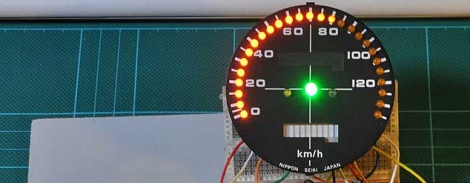
[Martyn] is restoring a 32-year-old Honda motorcycle, so when the ancient speedometer broke last year he thought it was prime time to start of a digital speedometer project. We’re loving the results so far, and would love seeing it on a nicely restored bike.
Instead of the relative horror of driving 40 LEDs with a single Arduino, [Martyn] bit the bullet and got a Maxim 7221 LED driver. Controlling 64 LEDs over a three-wire interface simplified the board design somewhat, allowing [Martyn] to etch his own PCB with the toner transfer & HCl/H2O2 method. To actually power and control the entire circuit, [Martyn] used an Arduino loaded up with a program based LedControl library makes programming the spedometer a snap.
Although the speedo works, [Martyn] says he isn’t proud of how it looks. We don’t mind – the candy colored jumpers add a nice flair to the project, and they’re hidden behind the face plate of the speedometer. We’re sure once he gets the neutral, high-beam, and warning indicators working with the LED bar array / tachometer, everything will look awesome.
via reddit















Could one use that Maxim 7221 to control multiple IR leds fast enough to be used to control tv/vcr/dvd boxes?
Probably not. The LEDs are scanned at some arbitrary internally generated frequency.
It might be possible to drive a smaller number of LEDs directly and introduce the carrier frequency to the current reference pin, but there are much easier ways of achieving the same thing.
Why? Are you controlling many boxes in different places? Or many different boxes in the same place?
If the former, just use a cheap micro to drive the LED and make a simple network (RS485?) to distribute your data.
If the latter, have one LED and send the code for each device sequentially. It’ll happen so fast it’ll appear that all the codes were sent at the same time.
Restored: You keep using that word, but I don’t think it means what you think it means….
Wouldn’t using a few LM3914’s be easier (and a lot cheaper)?
very nice but 120KPH is not exactly … fast :P
It actually goes to 140 kph. That’s probably plenty fast for pretty much anyone. I can probably count on one hand how many times I was doing more than 87 mph.
That’s km/h, not kph.
It could also be kmh-1 but I don’t know if the superscript markup is supported.
87mph is not very fast … atleast for me that’s just over highway speed :P
@andrew
km/h = KiloMmeter per Hour
kph = Kilometer Per Hour
same thing
Nice project, will follow to see how it all comes together. Thanks for posting this one.
My daily commute includes a stretch of I-435 and I-470. Depending on the time of day you’d better be going at least 85-95 mph depending on what lane you’re in. Otherwise you’ll get rear-ended, run off the road, or sometimes, pulled over and warned or fined for obstructing traffic.
That said 85-90 mph on a motorcycle is the baundary layer between enjoyable dangerous and sphincter puckering dangerous for me. It depends on the motorcycle in question of course. I have a hard time not thinking about contact patches, wind, and crap on the road too small to see until it’s too late at those speeds.
@bio : clearly you’ve never been to Europe. people drive at 140km/h on the highway. On some parts of the highway in Germany there is no speed limit.
@bio
(Why can’t we reply at any nesting level?)
kph is incorrect as k is not an SI unit, and p is never used as ‘per’ in SI.
km/h or kmh-1 (where -1 is superscripted) is correct. kph is not the same, it’s simply wrong.
They use kph in ST:TNG, which is enough of a standard for me :P
Arduino? Yawwwwwnnnn
troll? yaaaaaawn stfugtfokthnxbai
I’d just put a diffuser over the speed indicator LEDs. It would give a nice, “smooth” effect to it, like modern cars.
Just as a side note, if the speedometer cables used in motorcycles are anything like those in vehicles of the same era, they are fairly simple to fix. You just need to clean out the inside with a ton of degreasing agent (brake cleaner or whatever you want) and then unwind and re-grease it. This has brought back a number of speedo cables in late 60’s and 70’s vehicles I’ve worked on.
I’m not saying that I don’t like this more, I just bring it up in case the author, or any reader, could use the info…
But..
will it go to 88?
Also, another thought is to recycle a spare display from an old till POS display or VCR, then use each line as fine speed indicator.
Ought to be good to about +/- 0.5mph which is more than accurate enough.
No point in going to 88. He forgot to install the flux capacitor :P
“If my calculations are correct, when this baby hits 88 miles per hour, you’re gonna see some serious shit.” — Dr. Emmitt Brown
Very nice,
I saw a similar mod on VWV
(thread)
http://forums.vwvortex.com/showthread.php?2898256-LED-Project-2-DIY-MKIV-Instrument-Cluster-Upgrade-FINALLY
(video)
http://www.youtube.com/watch?v=1Wnu7OFZ0hQ
@asheets But if he puts the plutonium power source under the seat, he is going to end up sterile due to the radiation..
Seriously, did anyone notice that they used surplus military components in the BTTF car? Made it look that much more authentic, cobbled together from spare parts.
Constructive criticism, I would have used a backlit character display for speed and the outer right for tach like most bikes do with digital displays.
Otherwise, it does look cool and serves its purpose. This would be really cool on a bicycle to give you incentive to go faster :)
Hello, could spend the PBC scheme to print on the circuit board. my email bhalttar@gmail.com
Very good thank you!